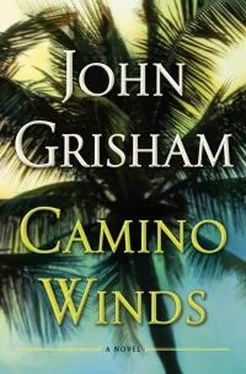ALSO BY JOHN GRISHAM
A Time to Kill
The Firm
The Pelican Brief
The Client
The Chamber
The Rainmaker
The Runaway Jury
The Partner
The Street Lawyer
The Testament
The Brethren
A Painted House
Skipping Christmas
The Summons
The King of Torts
Bleachers
The Last Juror
The Broker
The Innocent Man
Playing for Pizza
The Appeal
The Associate
Ford County
The Confession
The Litigators
Calico Joe
The Racketeer
Sycamore Row
Gray Mountain
Rogue Lawyer
The Whistler
Camino Island
The Rooster Bar
The Reckoning
The Guardians
The Theodore Boone Books
Theodore Boone: Kid Lawyer
Theodore Boone: The Abduction
Theodore Boone: The Accused
Theodore Boone: The Activist
Theodore Boone: The Fugitive
Theodore Boone: The Scandal
Theodore Boone: The Accomplice
This is a work of fiction. Names, characters, places, and incidents either are the product of the author’s imagination or are used fictitiously. Any resemblance to actual persons, living or dead, events, or locales is entirely coincidental.
Copyright © 2020 by Belfry Holdings, Inc.
All rights reserved. Published in the United States by Doubleday, a division of Penguin Random House LLC, New York, and distributed in Canada by Penguin Random House Canada Limited, Toronto.
www.doubleday.com
DOUBLEDAY and the portrayal of an anchor with a dolphin are registered trademarks of Penguin Random House LLC.
Cover design by John Fontana
Cover illustration by Debra Lill
Cover photograph ©Netfalls Remy Musser/Shutterstock
Library of Congress Control Number: 2020930911
Hardcover ISBN 9780385545938
Ebook ISBN 9780385545945
ep_prh_5.5.0_c0_r0
Contents
Cover
Also by John Grisham
Title Page
Copyright
Chapter One: The Landing
Chapter Two: The Crime Scene
Chapter Three: The Looters
Chapter Four: The Executrix
Chapter Five: The Miracle Drug
Chapter Six: The Consultant
Chapter Seven: The Fiction
Chapter Eight: The Informant
Chapter Nine: The Roundup
Chapter Ten: The Storm
CHAPTER ONE THE LANDING
1.
Leo spun to life in late July in the restless waters of the far eastern Atlantic, about two hundred miles west of Cape Verde. He was soon spotted from space, properly named, and classified as a mere tropical depression. Within hours he had been upgraded to a tropical storm.
For a month, strong dry winds had swept across the Sahara and collided with the moist fronts along the equator, creating swirling masses that moved westward as if searching for land. When Leo began his journey, there were three named storms ahead of him, all in a menacing row that threatened the Caribbean. All three would eventually follow their expected routes and bring heavy rains to the islands but nothing more.
From the beginning, though, it was apparent that Leo would go where no one predicted. He was far more erratic, and deadly. When he finally petered out from exhaustion over the Midwest, he was blamed for five billion in property damages and thirty-five deaths.
But before that he wasted no time with his classifications, advancing swiftly from tropical depression to tropical storm to a full-blown hurricane. At Category 3, with winds of 120 miles per hour, he hit the Turks and Caicos head-on and blew away several hundred homes, killing ten. He skirted low beneath Crooked Island, took a slight left, and aimed for Cuba before stalling south of Andros. His eye weakened as he lost steam and limped across Cuba, once again as a lowly depression with plenty of rain but unimpressive winds. He turned south in time to flood Jamaica and the Caymans, then, in a startling twelve-hour period, he reorganized with a perfect eye and turned north toward the warm and inviting waters of the Gulf of Mexico. His trackers drew a line straight at Biloxi, the usual target, but by then they knew better than to make predictions. Leo seemed to have a mind of his own and no use for their models.
Once again he rapidly grew in size and speed, and in less than two days had his own news special on cable, and Vegas was posting odds on the landing site. Dozens of giddy camera crews raced into harm’s way. Warnings were posted from Galveston to Pensacola. Oil companies scurried to extract ten thousand rig workers from the Gulf, and, as always, jacked up their prices just for the hell of it. Evacuation plans in five states were activated. Governors held press conferences. Fleets of boats and airplanes scrambled to reposition inland. As a Category 4, and veering east and west along a steady northbound trek, Leo seemed destined for a historic and ugly landfall.
And then he stalled again. Three hundred miles south of Mobile, he faked to his left, began a slow turn to the east, and weakened considerably. For two days he chugged along with Tampa in his sights, then suddenly came to life again as a Category 1. For a change he maintained a straight course and his eye passed over St. Petersburg with winds at a hundred miles per hour. Flooding was heavy, electricity was knocked out, flimsier buildings were flattened, but there were no fatalities. He then followed Interstate 4 and dumped ten inches of rain on Orlando and eight on Daytona Beach before leaving land as yet another tropical depression.
The weary forecasters said farewell as he limped into the Atlantic. Their models ran him out to sea where he would do little more than frighten some cargo ships.
However, Leo had other plans. Two hundred miles due east of St. Augustine, he turned north and picked up steam as his center spun together tightly for the third time. The models were reshuffled and new warnings were issued. For forty-eight hours he moved steadily along, gaining strength as he eyed the coast as if selecting his next target.
2.
At Bay Books in the town of Santa Rosa on Camino Island, the chatter among the clerks and customers was of nothing but the storm. Indeed, across the island, as well as from Jacksonville to the south and Savannah to the north, everyone was watching Leo and talking about him nonstop. By now most folks were well informed and could say with authority that no Florida beach north of Daytona had taken a direct hit in decades. There had been plenty of glancing blows as the hurricanes hurried north toward the Carolinas. One theory was that the Gulf Stream sixty miles out acted as a barrier to protect the Florida beaches and it would do so again with pesky Leo. Another theory was that the luck had run out and it was time for the Big One. The models were a hot topic. The hurricane center in Miami was now plotting a trajectory that sent Leo farther out to sea without landfall. But the Europeans had him coming ashore south of Savannah as a Category 4, with massive flooding in the low country. If Leo had proved anything, though, it was that he cared nothing for the models.
Bruce Cable, the owner of Bay Books, kept one eye on the Weather Channel while he hustled customers and chided his staff to get about their business. There wasn’t a cloud in the sky, and Bruce bought into the legend that Camino Island was immune to dangerous hurricanes. He’d been there for twenty-four years and had not seen a destructive storm. His store hosted at least four readings a week, and a major appearance was on for tomorrow night. Surely Leo would not disrupt the pleasant homecoming Bruce had planned for one of his favorite authors.
Mercer Mann was ending a two-month summer tour that had been wildly successful. Her second novel, Tessa, was the talk of the trade and currently in the top ten on all the bestseller lists. Its reviews were glowing and it was selling faster than anyone had expected. Labeled literary fiction, as opposed to one of the more popular genres, it had seemed destined for the lower rungs of the lists, if it made it at all. Its publisher, along with its author, had dreamed of selling thirty thousand in hardcover and e-book combined, but the novel was already beyond that.
Читать дальше












